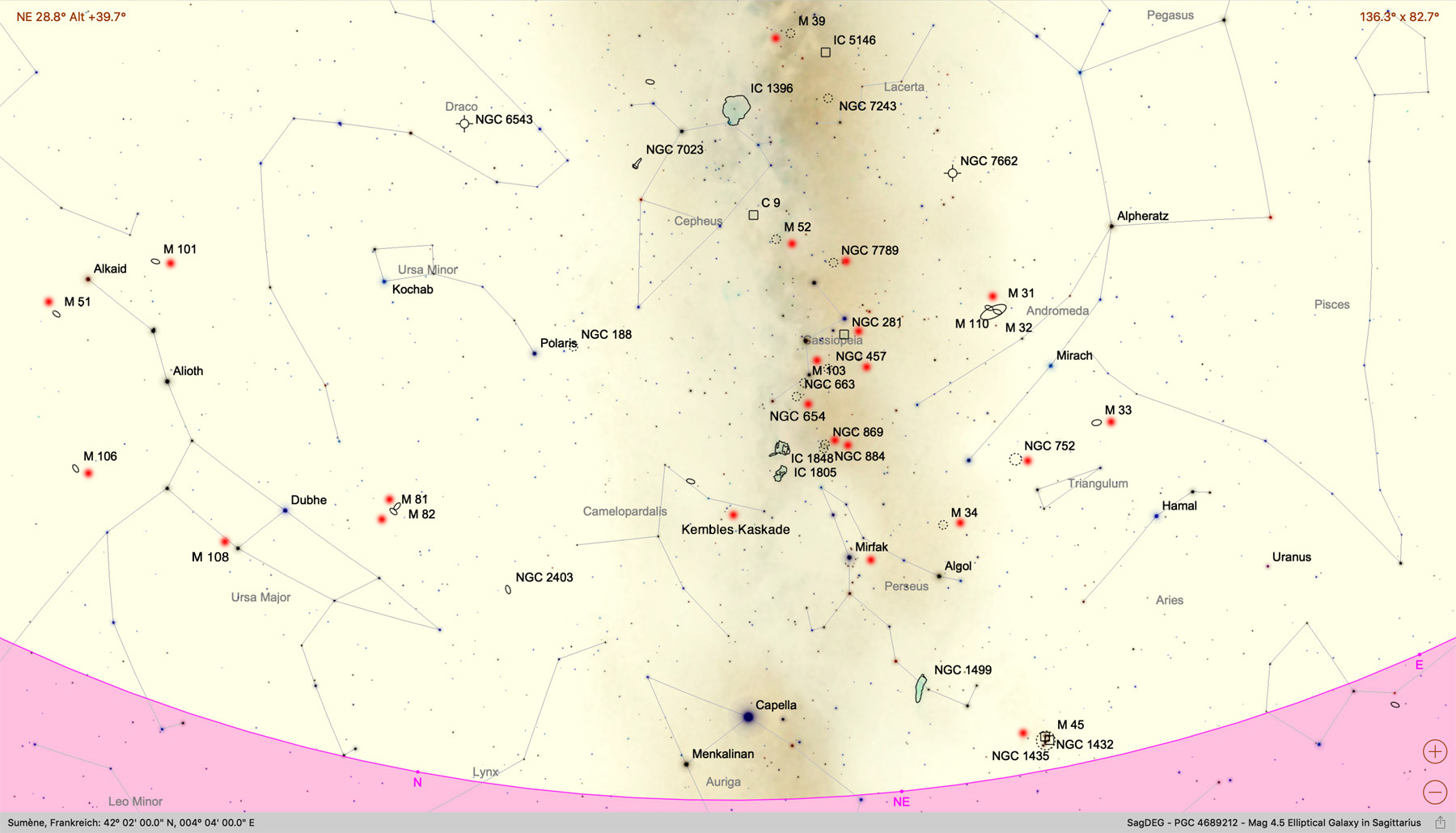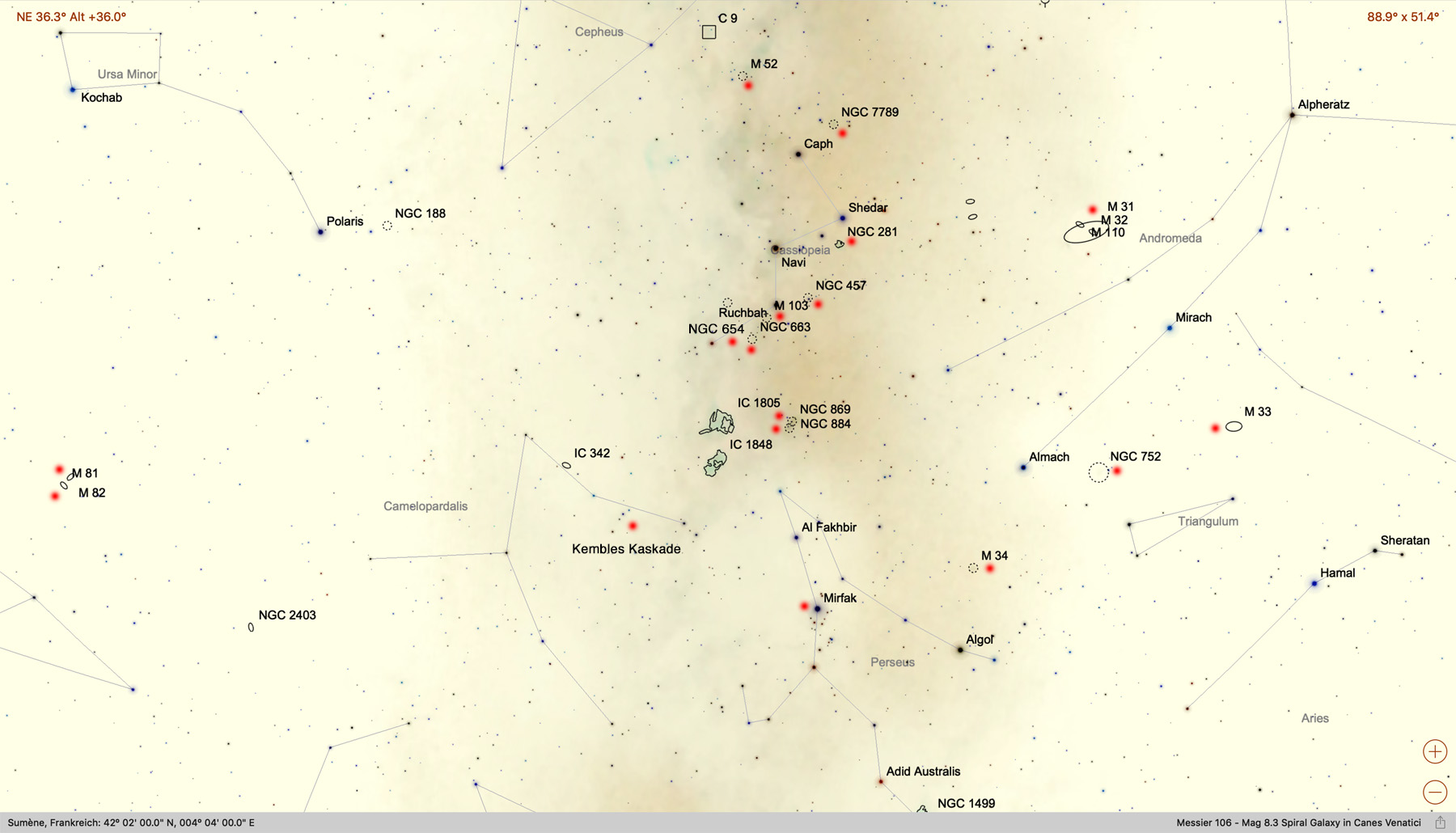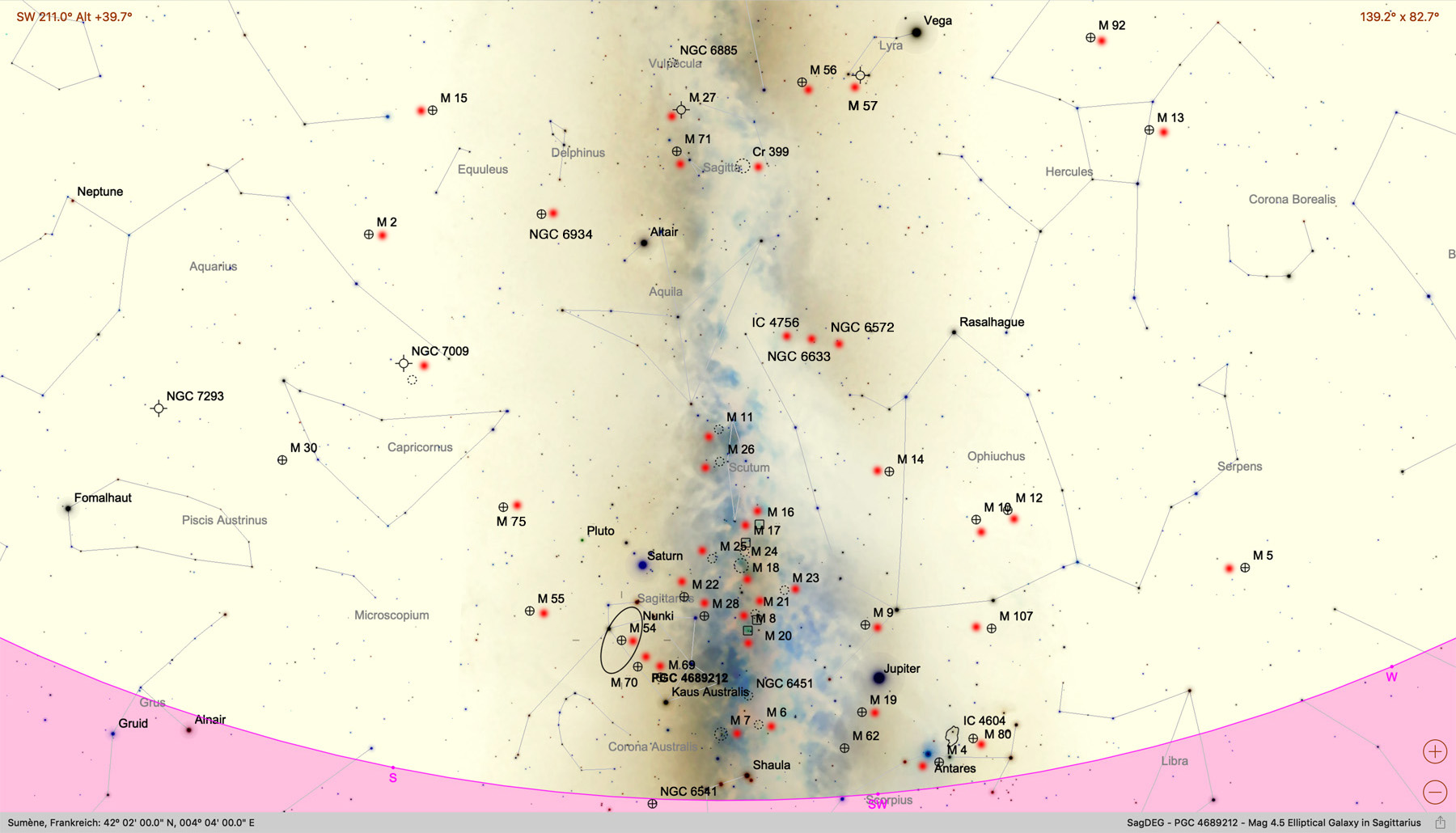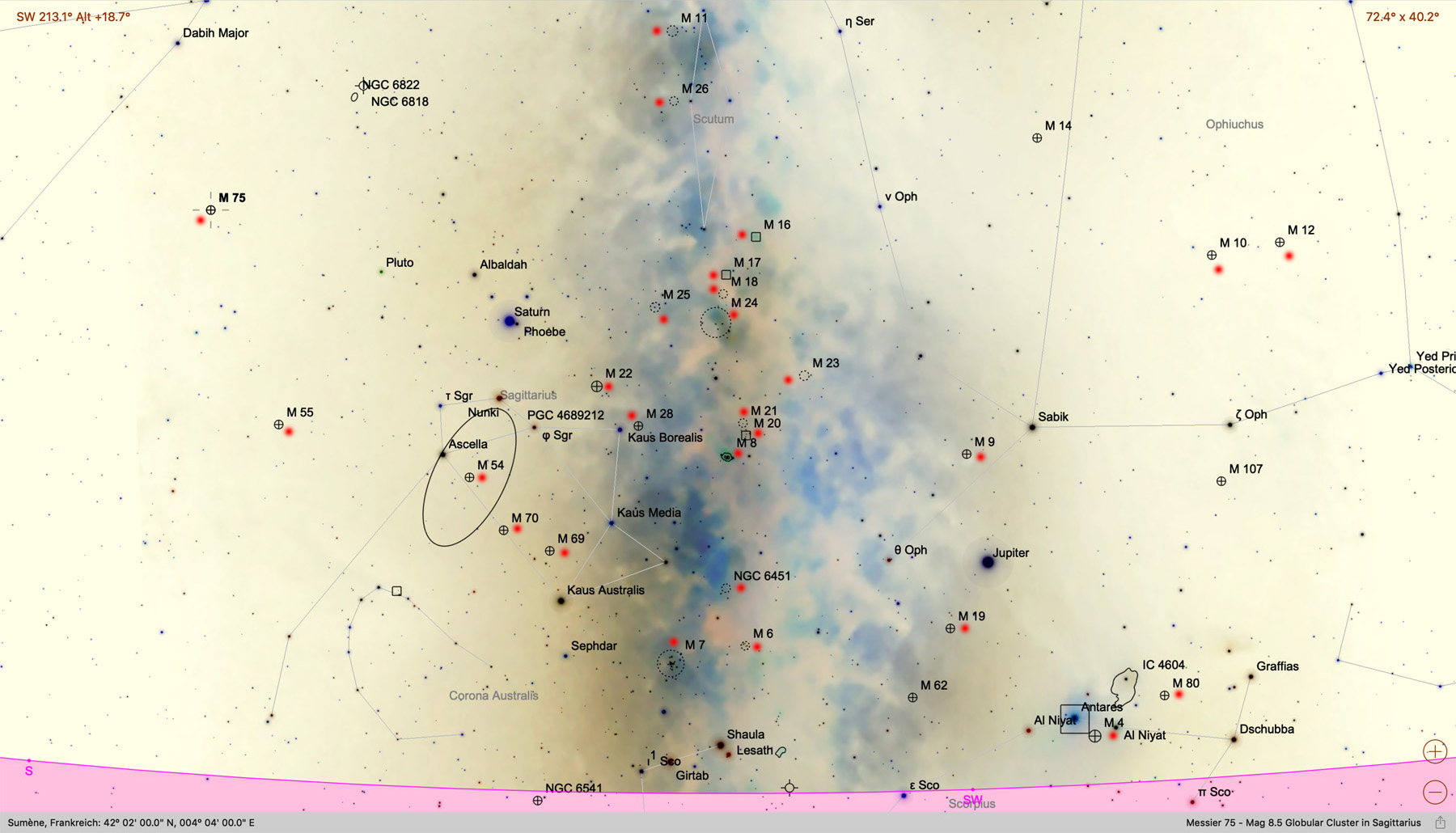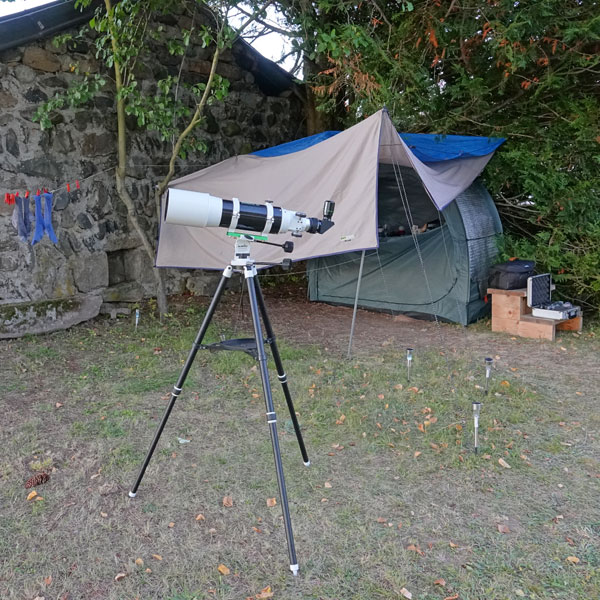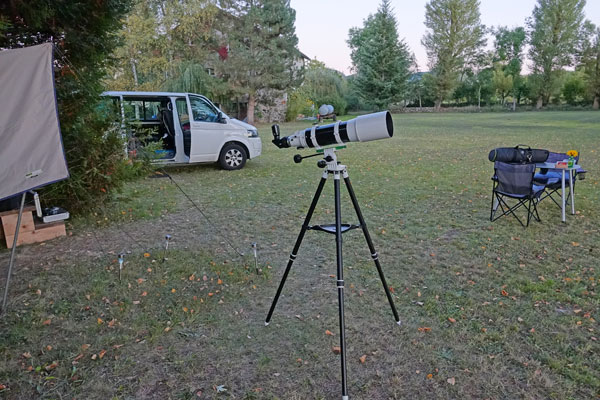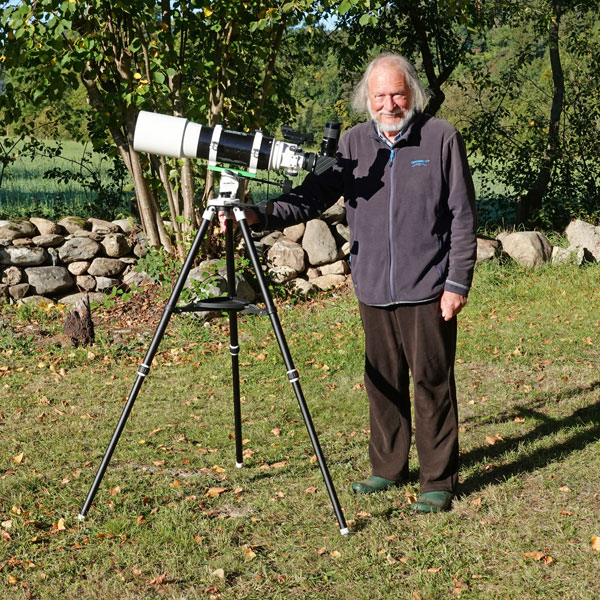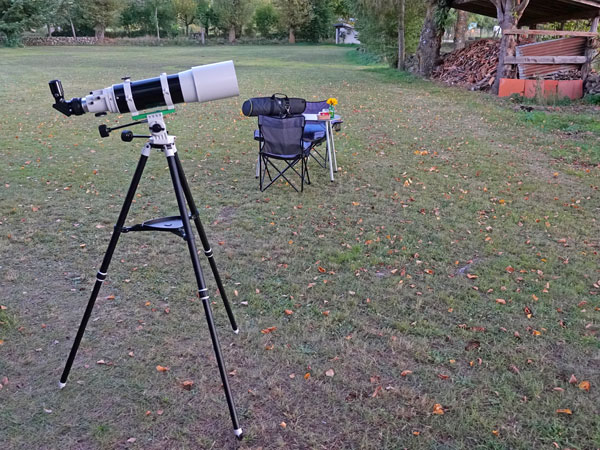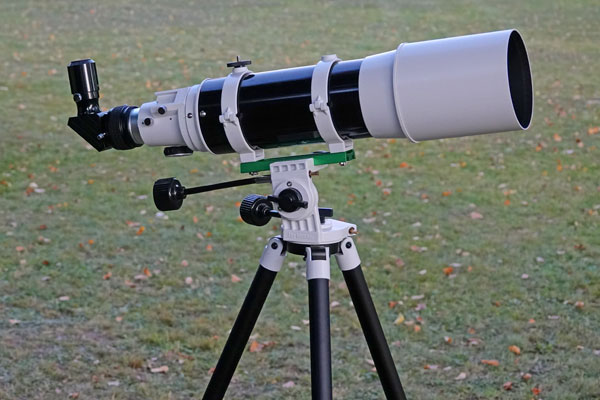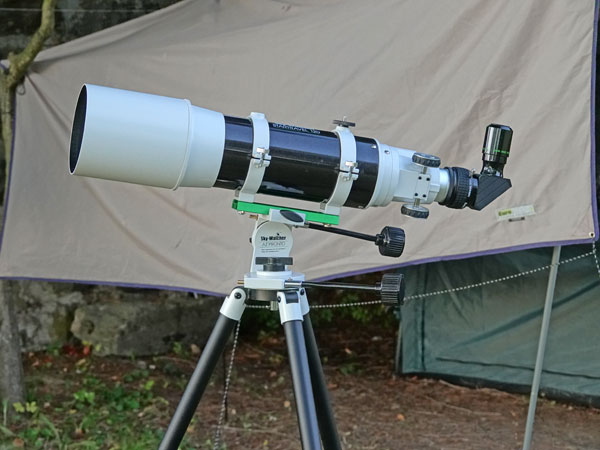Deep Sky Summer/Autumn Observations September - Mid-October 2019
Conditions | Observation Overview | List of Observed Sky Objects | References
In September 2019 up to the beginning of October, I did simple "deep-sky summer / autumn observations," which might be of interest to other beginners and are therefore described here. They took place in Sumène, Haute Loire, France, and were carried out with a borrowed Sky-Watcher StarTravel 120/600 refractor, my Omegon Photography Scope 72/432 refractor and with my binoculars.
In mid-October 2019, I observed some selected DSO with the borrowed Sky-Watcher StarTravel 120/600 refractor, my Omegon PS 72/432 refractor, my Sky-Watcher Explorer 150PDS Newtonian tube, and my Sky-Watcher Skymax-127 Maksutov-Cassegrain tube for a comparison of the telescopes; I add these observations to this page.
Note that more than 20 of the about 50 observation objects were new to me:
- Kemble's Cascade, M 9, M 14, M 19, M 107, M 4, M 80, M 26, M 18, M 21, M 22, M 23, M 24, M 28, M 54, M 55, M 69 , M 70, M 75, M 76, NGC 7000
Conditions
Sky Region and Objects
I observed in various sky areas as shown in the sky maps below.
Overview Maps
The following inverted maps shows approximately the sky area that I primarily browsed during my observations (and some of the observed objects)
Overview: North-East (not observed: M 39, M 52, M 101, M 106, M 108, NGC 281, NGC 7789) (Image Courtesy of SkySafari Astronomy, www.simulationcurriculum.com)
Detail: Northeast (not observed: M 52, NGC 281, NGC 7789) (Image Courtesy of SkySafari Astronomy, www.simulationcurriculum.com)
Overview: South-West (not observed: IC 4756, M 5, M 6, M7, M 62, NGC 6572, NGC 6633, NGC 6934) (Image Courtesy of SkySafari Astronomy, www.simulationcurriculum.com)
Detail: Southwest (not observed: M 6, M7, M 62, NGC 6451; observed: M 14) (Image Courtesy of SkySafari Astronomy, www.simulationcurriculum.com)
Click the maps for a larger version - they open in a new window
Observation Time
The observations were done in September/October 2019, typically after 9 p.m. and up to 11 p.m. or shortly after midnight (once).
Observation Location
The first series of observations took place in Sumène (close to Saint Julien-Chapteuil), Haute Loire (France):
- Coordinates: 45° 2′ N, 4° 4′ E
- Coordinates (dec.): 45.04° N, 4.06° E
The observations in mid-October 2019 took place in Mühlhausen/Kraichgau (Germany):
- Coordinates: 49° 15′ N , 8° 43′ E
- Coordinates (dec.): 49.25° N, 8.72° E
Devices Used
In France, I used my Leica Trinovid 10 x 25 BC binoculars (LT binoculars), my TS 10 x 60 binoculars, my Omegon 2.1 wide field binoculars (OM21), a borrowed Sky-Watcher StarTravel 120/600 refractor and my Omegon PS 72/432 refractor. I used my UWA eyepieces (7 mm, 4 mm), a Televue Delos 10 mm eyepiece, and a 24 mm Televue eyepiece for a maximum overview. Sometimes, I also used a TSED35 eyepiece (2", 35 mm focal length, 69° angle of view) and a borrowed TSWA32 eyepiece (2", 32 mm focal length, 70° angle of view). So this time I observed "manually" without any GoTo control!
|
ST120 on AZ Pronto mount on vacation in France |
||
In mid-October 2019, I with the borrowed Sky-Watcher StarTravel 120/600 refractor, my Omegon PS 72/432 refractor, my Sky-Watcher Explorer 150PDS Newtonian tube, and my Sky-Watcher Skymax-127 Maksutov-Cassegrain tube for a comparison of the telescopes. I used eyepieces in a manner to achieve a similar magnification (which was not always possible).
General Conditions
The sky above Sumène, Haute Loire (France) is relatively dark (the Betz observatory used by the Orion43 group is near-by). The milky way could be seen very well at times. In Mühlhausen/Kraichgau, the sky was not as dark as in France.
Observation Overview
| Date 2019 |
Observed Objects | Details, Remarks | Further Observations and Remarks | Devices Used | Eyepieces Used |
| Sep 17 | G: M 31 (Andromeda Galaxy) P: Cr 399 (Coat Hanger) OC: Mel 20 (Mirphac Cluster), NGC 884/869 (Perseus Double Cluster), M 11 (Wild Duck Cluster) |
OM21: M 31 small, Cr 399 seen just "half" and
with viewing indirectly, Mirphac cluster seen, Perseus Double Cluster seen
as a glow. Wandered along the sky; Dolphin, Cassiopeia seen as entire constellations; saw several "asterisms" (pattern like structures). All in all, the stars were much better to see than with the naked eye, but the sky background was quite bright... LT/TS: M 31; Cr 399, M 11 seen with "trapezium"; Mel
20; NGC 884/869 seen with "oval". |
Observations with OM21, LT and TS binoculars; a nice sky overall at about 9 p.m.; around 10 p.m. the moon was too bright | OM21 binoculars, LT and TS binoculars | |
| Sep 18 | G: M 31, M 51, M 81/82 (Bode/Cigar Galaxy) P: Cr 399 GC: M 15, M 2 OC: M 11, M 18?, M 23? GN: M 17? (Omega/Swan Nebula) Planets: Jupiter |
LT binoculars (Astrid): Cr 399 (hard to see), M
31 TS binoculars: M 31; used binoculars as a search aid Observations with the ST120 Andromeda: M 31 (24, 10 mm) large, more or less round Pegasus: M 15 (24, 10, 4 mm) beautiful, but not resolvable Jupiter: 4 moons, somewhat "colored" (24, 10 mm). |
First observation night with the StarTravel 120/600 . ST120: Bright stars had a somewhat bluish tint, no color fringes for DSOs. The moon disturbed observation a little, but at that time, I had more or less finished my observations ... |
ST120 on AZ Pronto, LT and TS binoculars | UWA 4 mm; WA 10 mm, 24 mm |
| Sep 19 | G: M 31, M 33 (Triangulum Galaxy), M 51, M
81/82 GC: M 22, M 28 OC: M 11, M 18 GN: M 17 (Omega/Swan Nebula) Planets: Jupiter, Saturn |
Observations with the PS 72/432
Andromeda: M 31 (24, 7, 4 mm) very nice Scutum: M 11 (24, 7, 4 mm) again seen very beautifully Sagittarius: Planets |
"Comparison observations" with my PS 72/432, a few new objects. At about 10:15 p.m., the sky was still very dark (I thought that the moon would disturb, but that was not the case...). I saw even M 31 (more indirectly) and the Perseus Double Cluster with the naked eye. |
PS 72/432 on AZ Pronto | UWA 4 mm, 7 mm; WA 24 mm |
| Sep 20 | G: M 31, M 51 GC: M 22, M 28, M 54 OC: M 11, M 18, M 23?, NGC 884/869 GN: M 8 (Lagoon Nebula), M 16 (Eagle Nebula), M 17 |
Observations with the ST120
Andromeda: M 31 (24, 7, 4 mm) very nice; seen or guessed
with the naked eye. Scutum: M 11 found by chance... Sagittarius |
The sky did not seem as dark to me as the day before, but I could still see the Perseus Double Cluster and M 31 with the naked eye, before the sky, probably due to the moon, got brighter again. | ST120 on AZ Pronto | UWA 4 mm, 7 mm, 16 mm; WA 24 mm |
| Sep 28 | GC: M 4, M 9, M 10, M 12, M 19, M
22, M 28, M 80, M 107 OC: M 11, M 21 GN: M 8, M 20 (Trifid Nebula) |
Observations with the ST120
Scorpius: M 4 (24, 10, 7, 4 mm): very low, very faint, with 4 mm probably resolved a bit into stars; M 80 (24, 10, 7, 4 mm): low, but a little higher up than M 4; somewhat brighter, small, between two stars (vertical line), with 4 mm perhaps resolved in to stars... Ophiuchus Sagittarius Scutum: M 11 (24, 10, 7, 4 mm): Very nice at all magnifications. |
New Moon; observed mainly globular cluster in constellation Ophiuchus. | ST120 on AZ Pronto | UWA 4, 7, 16 mm; WA 10 mm, 24 mm; 32 mm Plössl (initially) |
| Sep 29 | GC: M 13 OC: NGC 884/869, NGC 663? Planets: Jupiter |
Observations with the ST120 At first I thought that I would be able to continue my observations in the SW, but after dinner the sky was covered there. There were holes at Cassiopeia, where I tried to compare the 32 mm and 35 mm 2" eyepieces. I also walked along the sky a bit there. In between, a jump to Hercules, when Cassiopeia was covered, then back again, when Hercules was covered... An evaluation of the two eyepieces was difficult for me, especially since clouds often appeared when I wanted to test the other eyepiece. Shortly before 10 p.m. observations were no longer possible, and I ended my observations. I was still able to observe (with both eyepieces, no difference detected):
Everything looked nice, but was still relatively small (about 17 x / nearly 19 x, that is, twice the size as in 10 x binoculars). Jupiter seen at low magnification , 4 moons (Jupiter only used as search aid). |
Comparison of the 32 mm and 35 mm eyepieces (2", with 2" zenith mirror). Cloudy sky, which forced me to stop my observations. The 35 mm eyepiece can just be brought into focus! There is no room for fine focusing. |
ST120 on AZ Pronto | TSWA32, TSED35 |
| Sep 30 | G: M 31 GC: M 4, M 14, M 19, M 22, M 28, M 54, M 55, M 75, M 80 OC: M 11, M 25, M 26, M 45, M 69, M 70, Mel 20, NGC 884/869 Planets: Jupiter |
Observations with the ST120
Scorpius: M 4, M 80 (24, 10 mm) very low, particularly M 4 faint; M 80 somewhat better Ophiuchus: M 19 (24, 10, 7, 4 mm) had 3 stars on top of it, 2 to the right (= left) of it -> for identification - somewhat larger, faint, because low; not resolved; M 14 (24, 10, 7, 4 mm): was accompanied by three stars and a triangle -> for identification; small, faint at 4 mm, not resolved. Sagittarius Scutum: M 11 (24, 10, 7, 4 mm) very nice as always; M 26 (24, 10, 7, 4 mm) forms an obtuse triangle with two other stars, saw only few stars, but there should be 30 and more... At the end, I observed M 45, Mel 20, NGC 884/869, and M 31 with the 35 mm ED eyepiece; all were very nice; M 31 without structure, but with a bright core. Planets |
With that I probably had found all accessible lower DSO in the southwest; M 6, M 7, and M 62 did not seem to be accessible anymore. | ST120 on AZ Pronto | UWA 4, 7 mm; WA 10, 24 mm; TSED35 |
| Oct 3 | G: M 31, M 33 GC: M 13, M 56, M 71, M 92 OC: M 18, M 21, M 23, M 25, M 34, M 45, M 103, Mel 20, NGC 457, NGC 663, NGC 752, NGC 884/869 GN: M 8, M 17, M 20, NGC 7000 (North America Nebula) PN: M 27, M 57, M 76 (Small Dumbbell Nebula) SM: Kemble's Cascade, Cr 399 Part of the Milky Way: M 24 (Sagittarius Cloud) Planets: Jupiter, Saturn |
Observations with the ST120
Sagittarius Hercules: M 13 and M 92 seen well ; M 13 nearly from 10 mm on resolved into fine stars, but definitely from 7 mm on; M 92 from 7 mm on resolved into fine stars. 35 mm ED Eyepiece (together with Astrid) Lyra Sagitta: M 71 (24, 10, 7, 4 mm) somewhat resolved at 4 mm, nice, but faint Cygnus Vulpecula Perseus Andromeda Cassiopeia Triangulum: M 33 (24, 10 mm) was still a glow, but more distinct than ever before... Planets |
Galaxies in and around Ursa Major: nothing found (only searched for 10X-Galaxies, not for M 81/2) | ST120 on AZ Pronto | UWA 4, 7 mm; WA 10, 24 mm; TSED35 (briefly) |
| Oct 12 MH |
M 42/43, M 45, M 35 | Comparison StarTravel 120/600 with 10 mm Delos eyepiece (60
x) and 2" zenith mirror versus PS 72/432 with 7 mm UWA eyepiece
( 62 x) and 2"-to-1.25" Amici prism Due to a lack of suitable adapters, I had to use the Amici prism for simultaneous observations. Orion Nebula M 42/43 (60 x): After the telescopes had dried in the morning, the nebula was visible, but not as good as I have seen it already sometimes. Especially, Astrid found the nebula in the ST120 much better - the larger aperture paid off. After the drying, the trapezium could also be seen well in both telescopes, including the 4th weaker star. In the ST120 the upper and lower star in the sword just fit in at the edges (there were probably more than one); in the PS72 I did not check that... Orion Nebula M 42/43 (nearly 20 x with
32 and 35 mm 2" eyepieces): I was not able to find any differences
between the two eyepieces. However, the trapezium, which was now tiny,
was slightly better visible in the 32 mm eyepiece of 32 (like a star with
ears...); probably due to the slightly higher magnification of 18.75 x
versus 17. 14x. Further Targets: M 45 (Pleiades) were beautiful with 35 mm
and probably also with 32 mm eyepiece. Various targets seen with LT and TS binoculars: M 42/43, M 45, M 35 |
The evening before (Oct 11) I set up the telescopes and briefly
observed Jupiter and Saturn with them (60 x). In the morning they
were full of dew and had to be dried at the eyepiece and lens (the ST120
was a bit better because of the large dew cap, but also not free of dew).
Observation time approx. 4:50 to 5:50 o'clock on Oct 12 early in the morning. At the beginning, the moon was still visible, later its light still disturbed a little, although it had already set. Altogether, the situation in the morning became more and more unfavorable now, because the moon set later and later. The telescopes were fogged over after the observation, and therefore I left them in our winter garden; they were still wet in the morning. The ST120 was inside, probablyfogged over on the rear lens, and I let it dry up at noon for several hours outside and partly in the sun without a lid and open at the back. At first the thicker dew disappeared, but then the fine one as well. Thereafter, I packed it in its bag (after 2 - 2.5 hours). | ST120 on AZ Pronto, PS
72/432 on Sirui tripod (I could not access higher up
targets with it, e.g. Pleiades) LT and TS binoculars |
WA 10 mm, UWA 7 mm, TSWA32 (2") 32 mm, TSED35 (2") 35 mm |
| Oct 13 MH |
M 11 | Comparison StarTravel 120/600 with 10 mm Delos eyepiece (60
x) and 2" zenith mirror versus PS 72/432 with 7 mm UWA eyepiece
( 62 x) and 2"-to-1.25" Amici prism Due to a lack of suitable adapters, I had to use the Amici prism for simultaneous observations. M 11 (Wild Duck Cluster) | Full moon, clear sky, upcoming clouds at the end... The sky did not improve ober time... |
ST120 on Star Discovery mount (manually), PS 72/432 on AZ Pronto mount | WA 10 mm, UWA 7 mm |
| Oct 14 MH |
M 11
Jupiter, Saturn |
Comparison StarTravel 120/600 with 10 mm-Delos eyepiece (60
x) and 2"-to-1,25" Amici prism versus Skymax-127 with
24 mm eyepiece and 1,25" Amici prism Then comparison versus PS 72/432 with 7 mm UWA eyepiece and 2" zenith mirror Finally, comparison PS 72/432 versus Skymax-127, both with zenith mirror (2" and 1,25") M 11 (Wild Duck Cluster)
Jupiter/Saturn |
Clear sky, upcoming clouds at the end...
On this day, too, the sky did not get better in the course of time... >> I have probably never seen M 11 as bad as on these two days! >> The outcome of the test is actually as expected. A further comparison with the Explorer 150PDS would be interesting!
| ST120 always on Star Discovery mount, Skymax-127 OTA initially on AZ Pronto mount, later (versus PS 72/432) on Star Discovery mount, PS 72/432 on AZ Pronto mount | WA 10 mm, UWA 7 mm, WA 24 mm |
| Oct 16 MH |
M 11
Jupiter, Saturn |
Comparison StarTravel 120/600 with 10 mm Delos eyepiece (60
x) and 2" zenith mirror versus Explorer 150PDS with
16 mm eyepiece and 24 mm eyepiece with 2 x focal extender At the end, I observed with diverse eyepieces (7/10 and 4/7 ST/Exp), to check for higher magnifications M 11 (Wild Duck Cluster) Jupiter/Saturn |
Clear sky, upcoming clouds at the end...
On this day, as well, the sky became a little better in the course of time, but cloud strips came again and again, and at the end, clouds came in from southwest. >> The test actually went as expected: the Explorer 150PDS probably had some advantages compared to the ST120 (this was mainly Astrid's opinion). Summa Summarum (October 12-16) The performance order seems to follow the "effective" aperture:
The Exp150 may be a bit better than the ST120, but it is not for travel! | ST120 on AZ Pronto mount, Explorer 150PDS on Star Discovery mount (manually; this time, it worked quite well!) | 10 mm WA, 16 mm UWA, 24 mm WA, 4 mm UWA, 7 mm UWA |
Bold: First observation during this observation period; all observations up to Oct 3, 2019 in Sumène/Haute Loire (France), the remaining ones in Mühlhausen/Kraichgau (Germany); G = galaxy, OC = open star cluster, GC = globular star cluster, GN = galactic nebula, PN = planetary nebula, P = star pattern, DS = double star
List of Observed Sky Objects
Object details can be obtained via the links to the relevant deep sky objects.
|
DSO Details
|
Name | Constellation | Type | Bino* | PS72 | ST120 | Other | Remarks |
| M 81/82 | Bode Galaxy (M 81), Cigar Galaxy (M 82) | Ursa Major | G | yes | yes | Seen well, but still faint with 4 mm both galaxies were located at opposing edges of the field of view; I therefore observed than alone; I was able to see both in the field of view with the other eyepieces. | ||
| NGC 457 | Owl, E.T. Cluster | Cassiopeia | OC | yes | Found it surprisingly well with 24 mm thanks to the "bright eyes"; large with 10 mm; wonderful with 10 and 24 mm, never seen so clearly (I think so...) | |||
| M 103 | Cassiopeia | OC | yes | Probably seen but not yet verified | ||||
| NGC 663 | Cassiopeia | OC | yes | Probably seen NGC 663 with 24 mm, NGC 654 probably not; maybe also seen with 35 mm. | ||||
| Kemble's Cascade | Camelopardis | P | yes | Very nice, vertical chain of stars, slightly bent at the bottom (35 mm) | ||||
| M 51 | Whirlpool Galaxy | Canes Venatici | G | yes | yes | Hardly seen, more guessed with ST120; Astrid at least saw two glowing spots; with PS72 as good or bad as with ST120 (from my memory...); when repeated with ST120 very faint again. | ||
| M 13 | Hercules Cluster | Hercules | GC | yes | Nice with 35 mm, but relatively small; seen well with shorter eyepieces; fine stars almost seen from 10 mm on, but definitely from 7 mm on. | |||
| M 92 | Hercules | GC | yes | Seen well; fine stars from 7 mm on. | ||||
| M 57 | Ring Nebula | Lyra | PN | yes | Not found with 24 mm, but found with 10 mm and shorter; also observed with 7 and 4 mm; guessed a hole/ring at 4 mm... | |||
| M 56 | Lyra | GC | yes | Small with 24 mm, then observed with 10, 7, and 4 mm; slightly resolved at 4 mm. | ||||
| M 9 | Ophiuchus | GC | yes | Small, bright core, appeared as somewhat irregular; not resolved. | ||||
| M 10 | Ophiuchus | GC | yes | Searched for a long time for M 10 and M 12, because there are no guiding stars nearby; with 4 mm perhaps resolved in to stars | ||||
| M 12 | Ophiuchus | GC | yes | Searched for a long time for M 10 and M 12, because there are no guiding stars nearby; resolved into stars, smaller than M 10 and seemingly somewhat irregular. | ||||
| M 14 | Ophiuchus | GC | yes | Small, faint at 4 mm, not resolved (was accompanied by three stars and a triangle -> for identification) | ||||
| M 19 | Ophiuchus | GC | yes | Somewhat larger, faint, because already low, but just seen; not resolved (under two oblique stars; had 3 stars above it, 2 on the right (= left) -> for identification/clarification!!!) | ||||
| M 107 | Ophiuchus | GC | yes | Seen well, because higher up than the Scorpius globular clusters, with 4 mm perhaps resolved into stars. | ||||
| M 4 | Scorpius | GC | yes | Very low, very faint, with 4 mm probably resolved a bit into stars. | ||||
| M 80 | Scorpius | GC | yes | Low, but a little higher up than M 4, therefore somewhat brighter, small, located between two stars (vertical line), with 4 mm perhaps resolved in to stars... | ||||
| NGC 7000 | North Amerika Nebula | Cygnus | GNE | yes | searched for with 24 and 10 mm, perhaps a glow - that would be more than ever... | |||
| Cr 399 | Coat Hanger | Vulpecula | P | TS, LT, OM21 | yes | SM127 | With OM21 seen just "half" and with viewing indirectly; just fits the field of view at 24 mm, nice (turned upside down). Incomplete with SM127. | |
| M 27 | Dumbbell Nebula | Vulpecula | PN | yes | SM127 | Nice, large, maybe a little square-like... | ||
| M 71 | Sagitta | GC | yes | SM127 | Somewhat resolved at 4 mm, nice, but faint | |||
| M 11 | Wild Duck Cluster | Scutum | OC | yes | yes | Exp150, SM127 | Again seen very nicely at all magnifications; from a magnification of 60 x and up appeared fine stars. | |
| M 26 | Scutum | OC | yes | Forms an obtuse triangle with two other stars, saw only few stars, but there should be 30 and more... | ||||
| M 16+IC4703 | Eagle Nebula (OC: M 16/NGC 6611, GN: IC 4703) | Serpens Cauda | OC/GN | yes | M 16 denotes the star cluster, IC 4703 the GN around it; only found the star cluster (not IC 4703; no nebula filter) | |||
| M 8+NGC 6530 | Lagoon Nebula (OC: NGC 6530, GN: M 8/NGC 6523) | Sagittarius | OC/GN | yes | M 8 denotes these days the GN NGC 6523, Stoyan includes the OC NGC 6530 in it; seen very well, beautiful at all sizes; nebula and fine stars, large | |||
| M 17 | Omega/Swan Nebula (GN: M 17/NGC 6618) | Sagittarius | GN | yes | yes | Saw the nebula M 17 with a straight nebula-like glow at the center, below the nebula there was a small OS, namely M 18 with only few stars; both not identified initially; found both again on Sep 19 and identified them according to Stoyan as M 17 and M 18. Saw them well later again. | ||
| M 18 | Sagittarius | OC | yes | yes | Saw the nebula M 17 with a straight nebula-like glow at the center, below the nebula there was a small OS, namely M 18 with only few stars; both not identified initially; found both again on Sep 19 and identified them according to Stoyan as M 17 and M 18. Saw them well later again. | |||
| M 20 | Trifid Nebula | Sagittarius | GN | yes | Faint glow, only stars otherwise; saw only stars at further observations. | |||
| M 21 | Sagittarius | OC | yes | Only stars, not really identified (only position: small triangle in rhombus); fine stars at a second observation (24 mm) | ||||
| M 22 | Sagittarius | GC | yes | yes | Large and beautiful, particularly at 24 and 10 mm; appeared resolved differently on various days | |||
| M 23 | Sagittarius | OC | yes | Seen well, large, fine stars (there was a star next to it) | ||||
| M 24 | Sagittarius | MW | yes | The Sagittarius Cloud is part of the Milky Way, is large, and has many stars (24 mm) | ||||
| M 25 | Sagittarius | OC | yes | Large, to the left of M 24 (24 mm) | ||||
| M 28 | Sagittarius | GC | yes | yes | Close to M 22, much smaller, resolved into fine stars with 4 mm | |||
| M 54 | Sagittarius | GC | yes | Very small, but seen well, bright core, not resolved. At my first attempt, I was not able to find the two other DSOs (M 70, M 69) to the right of it, because they were already too low. I found them at a later date. | ||||
| M 55 | Sagittarius | GC | yes | Found M 55 more or less by chance, nice, larger than the nearby M 75; resolved at 7 and 4 mm, fairly faint at 4 mm. | ||||
| M 69 | Sagittarius | GC | yes | Still small at 4 mm, faint at 4 mm (small star nearby -> for identification) | ||||
| M 70 | Sagittarius | GC | yes | Small (located close to a longer chain of stars -> for identification) | ||||
| M 75 | Sagittarius | GC | yes | Very hard to find, at 4 mm still very small, not resolvable. | ||||
| M 15 | Pegasus | GC | yes | SM127 | Beautiful, but not resolvable | |||
| M 2 | Aquarius | GC | yes | SM127 | Beautiful, but not resolvable | |||
| M 31 | Andromeda Galaxy | Andromeda | G | yes | yes | Already seen with the naked eye (very faint); small with OM21, good to see with LT/TS binoculars; very nice with ST120 (also with 24 and 10 mm), but no structure or satellite galaxies found. | ||
| NGC 752 | Andromeda | OC | yes | Large, wide-spread | ||||
| M 33 | Triangulum Galaxy | Triangulum | G | yes | yes | Faint to very faint; at best it was still a glow, but more distinct than ever before... | ||
| NGC 884/869 | Perseus Double Cluster | Perseus | OC | yes | Already seen with the naked eye; very nice at low magnification and in binoculars; at 35 mm, the "oval" still fits into the field of view. Observed under various conditions. | |||
| M 34 | Perseus | OC | yes | Wide-spread | ||||
| M 76 | Small Dumbbell Nebula | Perseus | PN | yes | Very small; not found with 24 mm, only with 10, 7, and 4 mm | |||
| Mel 20 | Alpha Persei Cluster, Mirphak Cluster | Perseus | OC | LT/TS | yes | Very nice; observed with binoculars and long-focal eyepieces. | ||
| M 45 | Pleiades/Seven Sisters | Taurus | OC | LT/TS | yes | yes | Seen very nicely (later at night, in the morning) | |
| M 42/43 | Orion Nebula | Orion | GN | LT/TS | yes | yes | Visible, but not as good as sometimes already seen (in the morning) | |
| M 35 | Gemini | OC | LT/TS | yes | yes | Only faintly visible, but confirmed with binoculars (in the morning) |
*) LT = 10 x 25 binoculars, TS = 10 x 60 binoculars; G = galaxy, OC = open star cluster, GC = globular star cluster, DS = double star, P = star pattern, GN = galactic nebula, PN = planetary nebula, MW = Milky Way
Searched for, but not found: M 6, M 7, M 62
References
Books
- Michael Feiler & Philip Novak (2023). Deep Sky Reiseatlas (5. Auflage), Oculum Verlag (ISBN 978-3-949370-04-5)
www.oculum-verlag.de/detailview?no=608 - Ronald Stoyan (2021). Deep Sky Reiseführer (6. Auflage), Oculum Verlag (ISBN 978-3-938469-72-9)
www.oculum-verlag.de/detailview?no=603 - Erich Karkoschka (2022). Atlas für Himmelsbeobachter, Kosmos Verlag (EAN: 9783440173602)
www.kosmos.de/de/atlas-fur-himmelsbeobachter_1074889_9783440173602
On this Website
- Overview of Observations
- DSO List (Collected from Books)
- Omegon Photography Scope 72/432 ED OTA Information (2.8" Refractor)
- Sky-Watcher StarTravel 120/600 OTA Information (4.7" Refractor, Borrowed)
- Sky-Watcher Explorer 150PDS Information (6" Newton)
- Sky-Watcher Skymax-127 OTA Information (5" Maksutov-Cassegrain)
- Sky-Watcher AZ Pronto Mount Information
- Sky-Watcher Star Discovery AZ GoTo Mount Information
- My Binoculars
- My Starfield Binoculars
| 28.04.2024 |
